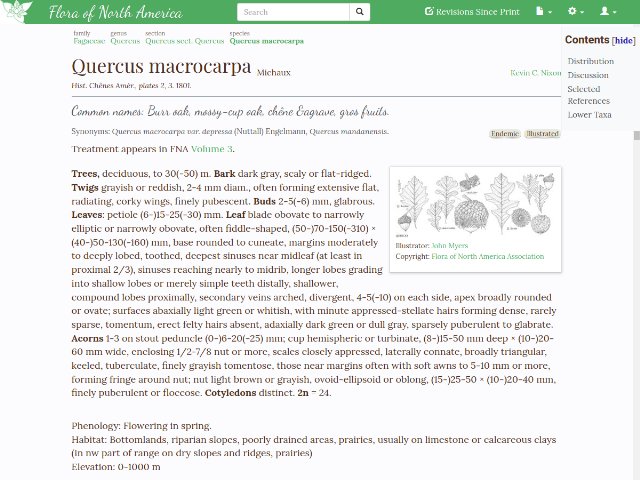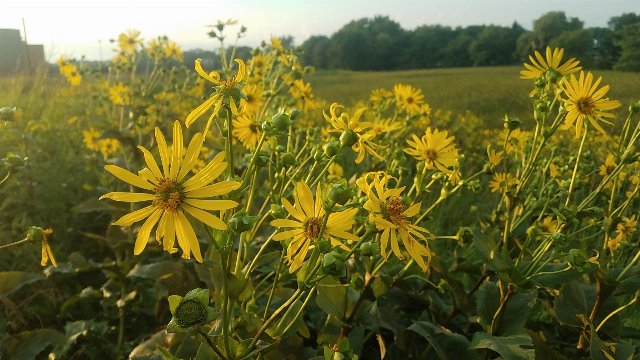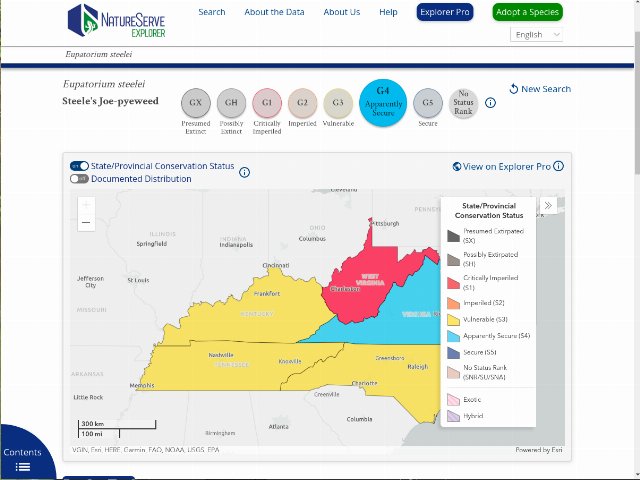New Databases Linked: Flora of North America & NatureServe Explorer
November 11th, 2022 by Alex Zorach
A little less than two years ago, we announced the linking of our plant articles with various other websites and plant databases. We are pleased to announce continued progress on this front, and we want to highlight the most recent two additions to our collection of links on each plant article: Flora of North America and NatureServe Explorer. This post will explain a little about each site and the ways in which each is most useful.Flora of North America
Flora of North America (FNA) is a massive project to collect in a single reference the names, taxonomic relationships, distribution info, and morphological descriptions of all plants occurring in the wild in North America north of Mexico. The material is available both in print volumes, and on the web. Formerly, FNA was only available through the efloras.org website, which also hosts other floras including Flora of China, Flora of Missouri, and several others. However, recently FNA has moved to its own dedicated website, which is more readable, mobile-friendly, and slightly more feature-rich.Our interlinking with FNA coincides roughly with FNA's dedicated website graduating from its "beta test" period, so we have linked only to the newer site.
 This screenshot of FNA's entry for bur oak (Quercus macrocarpa) shows the detailed morphology section, the most extensive part of FNA. This page happens to be illustrated, but most are not.
This screenshot of FNA's entry for bur oak (Quercus macrocarpa) shows the detailed morphology section, the most extensive part of FNA. This page happens to be illustrated, but most are not.FNA is only partly complete, but even in its incomplete form, it represents an unparalleled resource, especially for its description of the morphological characteristics of each plant, which are useful for performing rigorous plant identification. It is important to note, however, that FNA is a better resource for certain types of information than others. We have found its descriptions of morphology to be its best / most useful aspect.
FNA not only has records for species, but also for higher (families, subfamilies, genera, subgenera, sections, etc.) and lower (subspecies, varieties) taxa as well. Furthermore, at each level there are dichotomous keys that can allow you to rigorously work to narrow down an ID of a particular plant. If you are serious about plant ID you will likely benefit from using their site directly, not just following the links from our site, as it has a much richer structure and organization than is evident from our links alone.
Another particular strength is that FNA covers a larger area, so the information on plant morphology covers a larger range of natural variation that is often omitted in state or regional sources. As such, when used for rigorous ID, FNA's material remains applicable over a much larger area. Although regional sources can be easier to use to identify plants in their specific region, they often become inaccurate if used outside their scope.
Limitations or Shortcomings of FNAIn some cases, FNA also provides information on habitat; where this information is present it tends to be highly accurate, but the presence and/or depth of this information is inconsistent.
The information on plant ranges and distribution is mostly coarse, presented only at the level of states and provinces, occasionally supplemented by brief verbal descriptions, but nowhere near the level of detail of BONAP, USDA, or any of the regional resources we consult. There are also many plant populations, especially introductions, missed by FNA, so in general it tends to under-report plant ranges.
Arguably a more serious problem with FNA is that it often marks plants as native to regions where they most certainly are not native. There are multiple causes for these oversights. In some cases, FNA perpetuates the failure of USDA PLANTS and other earlier sources to distinguish between plants native to a continent, but introduced or expanding elsewhere. For example, FNA marks the prairie sunflower (Helianthus petiolaris) as native everywhere in North America, whereas it is has expanded its range or been introduced both east and northwest of its native range.
 Cup plant (Silphium perfoliatum) is one of many plants native to much of North America but that has been introduced and/or expanded northeast of its native range; this pattern is common in the Heliantheae or sunflower tribe. FNA does not make these distinctions and marks these plants as native everywhere they are found in North America. Photo © Andrew St. Paul, CC BY 4.0, Source.
Cup plant (Silphium perfoliatum) is one of many plants native to much of North America but that has been introduced and/or expanded northeast of its native range; this pattern is common in the Heliantheae or sunflower tribe. FNA does not make these distinctions and marks these plants as native everywhere they are found in North America. Photo © Andrew St. Paul, CC BY 4.0, Source.
In other cases, the errors relate to sloppy or incorrect plant taxonomy; for example FNA does not distinguish between any subspecies of the common reed, Phragmites australis, and wrongly reports this as one species native to everywhere it is found in North America, when in reality most populations are introduced from Europe, and the native and introduced populations are considered by most authorities to belong at least to separate subspecies, and by many (including us) to be separate species, the Eurasian common reed (Phragmites australis) and American common reed (Phragmites americanus). The distinctions between these species/subspecies is particularly relevant as the introduced taxon, whether treated as a species or subspecies, is one of the most damaging invasive plants in North America, whereas the native one is endangered. Holding onto the older treatment in this case is particularly inexcusable, as their entry on the common reed has been updated as recently as 2021, while evidence for the separate populations was published in 2004.
For these reasons we recommend ignoring the information presented by FNA on range and plant's status in an area as native or introduced. We will update our recommendations if we see evidence that FNA has systematically addressed these deficiencies. We continue to find BONAP and regional sources such as the Maryland Biodiversity Project, Calflora, E-Flora BC, and various state and regional plant atlases to be the best sources to consult for assessing plant ranges and status in a region, and we recommend checking these sources if you want detailed information on exactly where a plant occurs, that goes beyond what you can find on our current-generation range maps.
FNA's presentation of plant taxonomy is inconsistent. In some cases, it provides exceptional clarity, giving detailed explanations of relationships that are often not clearly explained in most sources. However, in other cases it can be deficient in its treatment of taxonomic relationships, either by holding onto outdated treatments rejected by most modern authorities, or in some cases using a reasonable, up-to-date treatment but providing no explanation for potentially confusing relationships or changes in the taxon in question. On average, FNA is significantly slower to incorporate new information than Plants of the World Online (POWO), which we have found to have the best and most up-to-date information on plant names and taxonomy.
NatureServe Explorer
NatureServe Explorer (NSE) is an entirely different type of resource from FNA, with complementary strengths. The focus of NatureServe Explorer is on conservation.
Although many websites provide state- and province-level range maps, NSE stands out in that its maps are color-coded, often with additional verbal information, to denote the conservation status of a particular species in each region. This information is highly relevant because most species, even the most common ones, are locally-endangered somewhere, typically around the edges of their range. NSE maps also show where species have been locally extirpated.
 This screenshot shows the color-coded state-level map for Appalachian joe-pye weed (Eutrochium steelei), which is classified as secure in Virginia, but critically imperilled in West Virginia and vulnerable in the rest of its range.
This screenshot shows the color-coded state-level map for Appalachian joe-pye weed (Eutrochium steelei), which is classified as secure in Virginia, but critically imperilled in West Virginia and vulnerable in the rest of its range.
The maps are only a small part of the resources provided by NSE. Although some articles are more complete than others, many of the plant pages on NSE have extensive verbal descriptions of the conservation issues relevant to the plant. This information often provides useful information both on the plant's habitat requirements, and the way these interact with human land use patterns and other potential threats to the plant's populations.
Lastly, in some cases, NSE provides explanation of taxonomic relationships, including discussion of historical changes, that can be hard to find elsewhere.
Limitations of NSE: Primarily Incompleteness
Like any resource, NSE has its limitations, and in this case, the largest issue is its incompleteness. In contrast with FNA, we have yet to find any major errors or misleading information on the site, but unfortunately NSE is less far along in its completion. A large portion of the maps on the site are incomplete, showing the ambiguous "no status rank" for large numbers of states and provinces. The finer spatial data using a hexagonal grid are available for even fewer species, and those with data usually only have it for a small part of the range.
In general, NSE's data are too incomplete to be a useful indicator of where the species occur. However, we have largely found the existing data to be accurate, especially when the written descriptions below are also consulted, as they often clarify various nuances.
Links Added To ID Guides
Because FNA is so useful for plant identification, we have added links to the FNA records for all ID/Comparison guides for which these records exist. In addition, we have displayed three other linked websites on these guides: Go Botany, which has a New England focus, Illinois Wildflowers, and Virginia Tech Dendrology Factsheets.
What is next?
Although we have interlinked the vast majority of records from both of these sites, there is still a lot of cleanup work to be done, notably, in the linking of records where the scientific names used by these sites differ from the names we use, as well as records where our treatment of taxa are merged or split relative to how they are treated on these sites. This work is much slower and more labor-intensive, and we have not even completed it for previously interlinked websites, including BONAP.
There are also numerous other databases and plant websites on our list to integrate with, and we hope to continue this work in the coming year.
And, of course, we have all the other work on our site, including new plant ID guides, new articles, and continual refinement and completion of more range maps.
 Cup plant (Silphium perfoliatum) is one of many plants native to much of North America but that has been introduced and/or expanded northeast of its native range; this pattern is common in the Heliantheae or sunflower tribe. FNA does not make these distinctions and marks these plants as native everywhere they are found in North America. Photo © Andrew St. Paul, CC BY 4.0, Source.
Cup plant (Silphium perfoliatum) is one of many plants native to much of North America but that has been introduced and/or expanded northeast of its native range; this pattern is common in the Heliantheae or sunflower tribe. FNA does not make these distinctions and marks these plants as native everywhere they are found in North America. Photo © Andrew St. Paul, CC BY 4.0, Source. This screenshot shows the color-coded state-level map for Appalachian joe-pye weed (Eutrochium steelei), which is classified as secure in Virginia, but critically imperilled in West Virginia and vulnerable in the rest of its range.
This screenshot shows the color-coded state-level map for Appalachian joe-pye weed (Eutrochium steelei), which is classified as secure in Virginia, but critically imperilled in West Virginia and vulnerable in the rest of its range.Archive of All Blogs
The Bias Against Tall Plants, November 11th, 2025
A Focus on Goldenrods (Solidago sp.), July 23rd, 2025
Disturbance and its Role in Plant Habitat Preferences, May 29th, 2025
What "Native" or "Introduced" Mean: Myths and Misconceptions, March 11th, 2025
Smarter & More Informative Search Results, January 13th, 2025
The Effect of the 2024 US Election on Plant Biodiversity and bplant.org, October 30th, 2024
The Problems With Nursery-Bought Plants, And The Solutions, October 8th, 2024
More Databases Linked & Search Improvements for Scientific Names, July 9th, 2024
Choosing The Best Common Names For Plants: Challenges & Solutions, April 19th, 2024
Range Map & Taxonomic Update Progress, January 31st, 2024
Giving Thanks To Everyone We Rely On, November 22nd, 2023
Thinking More Deeply About Habitat, April 5th, 2023
2022 Year-End Summary: Successes & New Goals, February 15th, 2023
New Databases Linked: Flora of North America & NatureServe Explorer, November 11th, 2022
All Range Maps 2nd Generation, Taxonomic Updates, & Fundraising Goal Met!, September 29th, 2022
More Range Map Improvements, POWO Interlinking, And Notes Fields, June 7th, 2022
Ecoregion-Based Plant Lists and Search, March 30th, 2022
Progress Updates on Range Maps and More, February 10th, 2022
The Vision for bplant.org, December 9th, 2021
New Server: Software & Hardware, August 30th, 2021
More & Improved Plant Range Maps, July 19th, 2021
A Control Section for Invasive Plants, April 15th, 2021
Progress Bars & State Ecoregion Legends, March 11th, 2021
Our 2020 Achievements, February 9th, 2021
Interlinking Databases for Plant Research, November 11th, 2020
A New Homepage, Highlighting Our Articles, July 29th, 2020
A False Recovery, But North Carolina's Ecoregions are Complete!, June 9th, 2020
We're Back After COVID-19 Setbacks, April 3rd, 2020
Help Us Find Ecoregion Photos, February 27th, 2020
What We Achieved in 2019, December 30th, 2019
Plant Comparison and ID Guides, October 30th, 2019
We Are Now Accepting Donations, October 14th, 2019
US State Ecoregion Maps, New Footer, Ecoregion Article Progress, and References, September 19th, 2019
Tentative Range Maps of Native Plants, August 12th, 2019
Ecoregion Locator and Interactive Maps, July 10th, 2019
Using Ecoregions Over Political Boundaries, May 13th, 2019
How We Handle Wild vs Cultivated Plants, April 16th, 2019
A Blog To Keep People Updated On Our Progress, April 8th, 2019
Sign Up
Want to get notified of our progress? Sign up for the bplant.org interest list!


